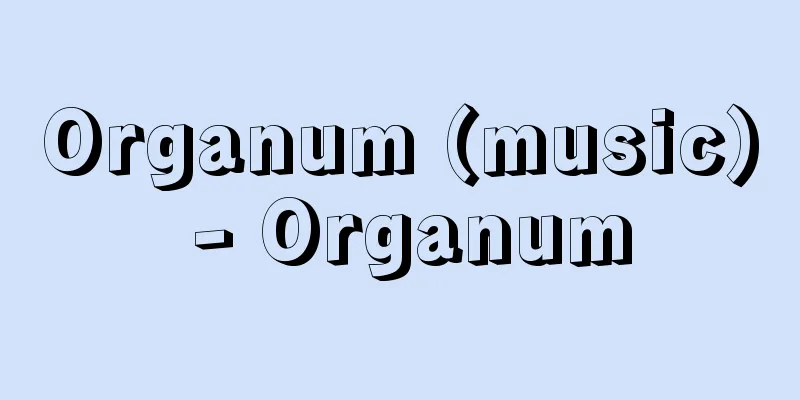Organum (music) - Organum

|
...The Abbey of Saint-Martial near Limoges in central France was a particularly important center around 1150 (Saint-Martial school). Their polyphony was called organum, a two-part composition with a long, drawn-out Gregorian chant in the lower voice and a freer, more detailed upper voice. From the end of the 12th century, the center of polyphony shifted northward, and Notre-Dame de Paris was particularly important until the end of the 13th century (Notre-Dame school, Paris school). ... From [Christian Music]…The cornerstone of Notre Dame de Paris was laid in 1163, but at the end of the 12th century, when the altar and the sanctuary were completed, two great masters, Léonin and Pérotin, appeared. They established an early polyphonic form called organum, which took Gregorian chant as its basis and layered one to three counterpoint melodies on it. The sound of this is far more brilliant than Gregorian chant, which was an ascetic prayer song, and is reminiscent of the brilliance of stained glass. … From the Notre Dame School…While previous polyphonic music followed the rhythm of Gregorian chant, Leonin established a strict rhythmic system based on 3 beats by combining major and minor notes, bringing about a revolutionary innovation in music history. Based on this rhythmic system, called modal rhythm, Leonin, a representative composer of the late 12th century, composed two-part organums with Gregorian chant as a fixed melody and countermelody added, and further compiled such works to be sung on major holidays throughout the year in the Magnus Liber Organi. His successor, Perotinus, revised this collection and left behind many three- or four-part organums. … From [Polyphony]… In Europe, the history of polyphony began with sacred vocal music. Its origins are unclear, but the oldest surviving example is the organum (Latin) found in the late 9th century theoretical work Musica Enchiriadis (Musical Manual). The earliest organums were mainly composed of two voices, a plainsong voice and an additional voice, progressing in parallel, and the independence of the voices was still weak. … From [Motet]…Broadly speaking, motets can be divided into medieval motets up to the late Gothic period, Renaissance choral polyphony motets, Baroque motets that combine a variety of styles, and motets from the late 18th century onwards from the Romantic period to the present. Medieval motets arose from an early form of polyphony called organum (Latin). Organum is a general term for a compositional technique in which a separate melody is added to the melody of Gregorian chant, and the first form that began around the middle of the 9th century was still crude. … *Some of the terminology explanations that mention "organum (music)" are listed below. Source | Heibonsha World Encyclopedia 2nd Edition | Information |
|
…中部フランスのリモージュ近郊にある聖マルシアル修道院は,1150年ころ,なかでも特に重要な中心であった(聖マルシアル楽派)。そのポリフォニーはオルガヌムorganumと呼ばれ,下声に長く引き伸ばされたグレゴリオ聖歌を置き,その上に自由なリズムで細かく動く上声を配した2声の楽曲であった。12世紀末からポリフォニーの中心地は北に移動し,13世紀末までパリのノートル・ダム大聖堂が特に重要な位置を占めた(ノートル・ダム楽派,パリ楽派)。… 【キリスト教音楽】より…パリのノートル・ダム大聖堂の礎石は1163年にすえられたが,祭壇と内陣の部分がまず完成した12世紀末,ここにレオナンLéonin(レオニヌスLeoninus)とペロタンPérotin(ペロティヌスPerotinus)という2人の巨匠が姿を現す。彼らはグレゴリオ聖歌を基礎として,1~3声部の対位旋律をそれに重ね合わせるオルガヌムorganumと呼ばれる初期のポリフォニーの形式を確立した。その響きは,禁欲的な祈りの歌であったグレゴリオ聖歌に比べれば,はるかに華麗であり,ステンド・グラスの光彩を思わせる。… 【ノートル・ダム楽派】より…それまでのポリフォニー音楽がグレゴリオ聖歌のリズムに準じていたのに対し,長短の音符の組合せによって3拍子を基本とする厳格なリズム体系を確立して音楽史に画期的な革新をもたらした。モーダル・リズムと呼ばれるそのようなリズム体系に基づいて12世紀後半の代表的作曲家レオナンLéonin(レオニヌスLeoninus)はグレゴリオ聖歌を定旋律としてそれに対旋律を付け加えた2声オルガヌムを作曲し,さらに1年を通じておもな祝日で歌われるそのような作品を集大成して《大オルガヌム曲集Magnus Liber Organi》を完成した。その後継者にあたるペロタンPérotin(ペロティヌスPerotinus)はこの曲集を改訂して,数多くの3声ないしは4声のオルガヌムを残した。… 【ポリフォニー】より… ヨーロッパではポリフォニーの歴史は宗教的声楽曲とともに始まる。その起源は定かではないが,現存最古の例は,9世紀末の理論書《ムシカ・エンキリアディス(音楽の手引き)》にみられるオルガヌムorganum(ラテン語)である。最初期のオルガヌムは,定旋律声部と付加声部の2声が平行進行するものが主体で,声部の独立性はまだ希薄であった。… 【モテット】より…時代的に大きく分ければ,後期ゴシックまでの中世のモテット,ルネサンス時代の合唱ポリフォニー様式のモテット,種々の作風をあわせもつバロック時代のモテット,18世紀後半以降ロマン派から現代に至るモテットに区分できよう。 中世のモテットは,オルガヌムorganum(ラテン語)と呼ばれる初期のポリフォニーの形態を母体として興った。オルガヌムとはグレゴリオ聖歌の旋律に対して別の旋律を付け加える作曲技法を総称し,9世紀半ばころに始まった最初の形はなお稚拙であった。… ※「オルガヌム(音楽)」について言及している用語解説の一部を掲載しています。 出典|株式会社平凡社世界大百科事典 第2版について | 情報 |
<<: Organum (machine) - Organum
Recommend
Ukintaku - Ukintaku
... According to the people of the Song Dynasty, ...
needle work
..."Shi" means to sew with a needle, an...
Mimash
Date of birth and death unknown. A naturalized pe...
Troost, C. (English spelling) TroostC
...This stagnation continued long into the 19th c...
Mount Mitsumatarenge - Mount Mitsumatarenge
A mountain in the center of the Northern Alps on ...
Ancient stories - Kojidan
A collection of tales from the early Kamakura per...
Michałowski, P.
… In the second half of the 18th century, Stanisł...
Kishibojin
(Free translation of Hārītī (Hāri 苫)) [1] In Buddh...
Aerial torpedo - Airborne torpedo
A torpedo dropped into the water by a torpedo bomb...
Schöffer, Nicolas
Born: September 6, 1912, Karoksa, Austria-Hungary ...
Bell Drum Dance - Suzudaikoodori
A type of Kabuki dance. Suzu-daiko, also called fu...
Servant - Hokounin
A person who serves a master. Originally it meant...
turbofan engine
...In the case of turbojet engines, the propulsiv...
Roggeveen, J.
…It is an isolated island located at 27°08′ south...
Food irradiation
Food is irradiated with radiation to sterilize, p...









